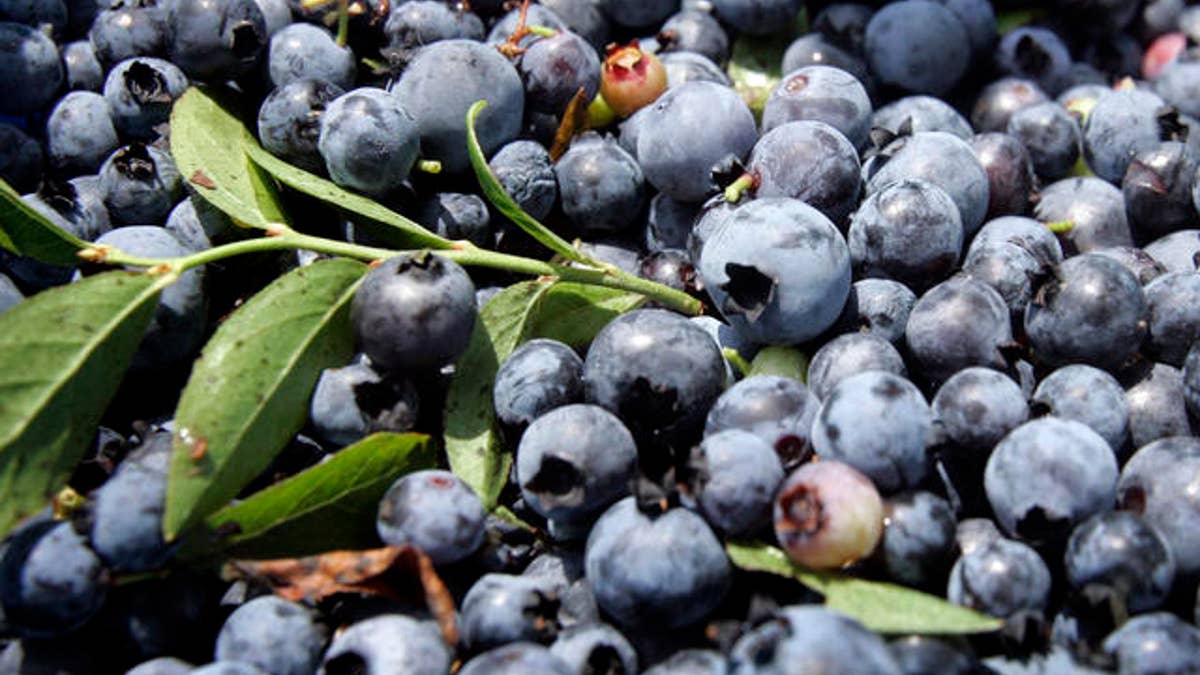
Blueberries are seen Tuesday, Aug. 7, 2007, in Union, Maine. A decade ago, about 20 percent of Maine's 60,000 acres of blueberry fields were harvested by mechanical means. Today, it's about 80 percent as growers discover that it's cheaper to replace hand pickers with more efficient machinery. (AP Photo/Robert F. Bukaty) (AP)
Hippocrates once said, “Let thy food be thy medicine!” but for the estimated 45 million Americans who suffer from Irritable Bowel Syndrome (IBS), that can be a tough pill to swallow. Symptoms of IBS can be uncomfortable, frustrating, and painful -- and are brought on directly by the foods consumed. It doesn't help that there is no specific test to diagnose IBS either. IBS is a sort of “subjective” condition where a lot of symptoms are clumped into one to form a diagnosis. Fortunately for those suffering from IBS, food may actually be “thy medicine”.
A new eating plan has been created, and proven with great clinical significance to help appease IBS symptoms. This belly-saving way of eating is based on “FODMAPs,” specifically “low FODMAP” foods. A 2014 Australian clinical trial published in the Journal of Gastroenterology has shown following a low FODMAP diet may reduce IBS symptoms by as much as 50 percent. The term “FODMAP” is an acronym that stands for “"Fermentable, Oligo-, Di-, Mono-saccharides And Polyols."
This plan identifies short chain carbohydrates that are potentially difficult for people to digest and ferment in the large intestine causing gas and other digestive stress. These short-chain carbohydrates include excess fructose, lactose, fructans, galactans, and polyols. Such carbohydrates are considered “high FODMAP” foods and thus should be avoided by those with IBS.
No one likes hearing the word “no,” so instead of telling you what you can’t eat, here’s what you can eat. Simple swaps (high FODMAPs out for low) that may make a huge difference in ways of digestion include:
1 Apples out for blueberries: An apple a day may keep the doctor away, but it may not keep IBS symptoms at bay. Apples are eliminated in a low FODMAP diet because they contain an excessive amount of fructose. Fructose is a type of sugar found in fruits. Foods that have excess fructose are considered high FODMAP and should be avoided by people who suffer from IBS. Such foods include apples, watermelon, cherries, mango, agave, and honey. Some fruits have less fructose than others though, and can safely be incorporated in a low FODMAP eating plan. Blueberries (20 blueberries), grapes (1 cup), orange (1 small), and kiwi (2 small) all make the low FODMAP list. Although these fruits are lower in fructose, people who suffer from IBS should still limit their overall fruit consumption as fructose in lower amounts can still add up when consumed in large quantities.
2 Artichokes out for eggplant: Foods high in fructan, a substance similar to fructose, and found in many vegetables and grains, are also high FODMAP and thus should be avoided. Foods high in fructans to avoid include: artichokes, garlic, leeks, scallions, onion, peas, and certain grains, nuts, and legumes. Before you swear off salads for life, know that there are plenty of low fructan vegetables that can be enjoyed by all. Eggplant, arugula, zucchini, sweet potato, spinach, tomatoes, and cucumbers all get the green light for low FODMAP dieters.
3 Pasta out for spaghetti squash: Aside from being high in carbohydrates and deliciousness, pasta is also high in fructans. For this reason, pasta is a no-go when following a low FODMAP plan. Other grains in addition to pasta that must be avoided include wheat and rye such as bread, crackers, cookies, and couscous. To get your pasta fix, you can make spaghetti squash or zucchini noodles, as both zucchini and squash are low FODMAP foods, or use a gluten-free pasta like quinoa pasta. Other suitable low FODMAP grain products and grains include gluten-free bread, millet bread, rice, and spelt bread.
4 Cottage cheese out for mozzarella cheese: A commonly known gastric irritant, lactose, is another defining characteristic of high FODMAP foods. Therefore, high lactose foods are also high in FODMAPs, and should be should be avoided if following a low FODMAP diet. Such high lactose foods include cottage cheese, milk, yogurt, and ricotta cheese. These high lactose foods can be swapped for dairy products that are lower in lactose such as lactose-free milk and cheese, hard cheeses like mozzarella and cheddar and feta cheese.
5 Kidney beans out for lentils - Beans beans they’re good for your heart, the more you eat, the more you… Well, let’s just say… they’re high in FODMAPS. Legumes like kidney beans, soy beans, black beans, split peas, garbanzo beans, navy beans are considered a high FODMAP food because of their high fructan content. Following a low FODMAP diet doesn’t mean beans are completely off limits though. Interestingly, canned beans have a lower FODMAP value than regular, and of legumes, lentils are your best bet. Swap any of the beans mentioned above for 1/4 cup canned lentils to get your bean-on in a way that will be more comfortable for you… and those around you….
Before starting a low-FODMAP diet, consider working with a Registered Dietitian to properly design a healthful eating plan that will meet all of your macro and micronutrient needs. Another option is to invest in an app like “The Monash University Low FODMAP Diet” which makes identifying suitable and unsuitable foods easy. You can also get their low FODMAP diet booklet.




















